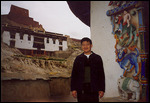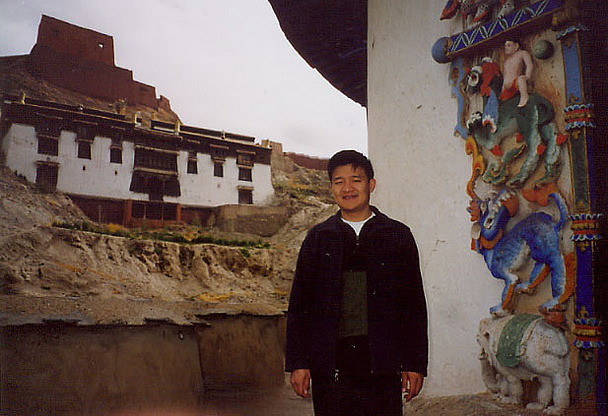The next day was spent driving, until we arrived in Gyantse in the evening. At one point we had to drive into a good sized river at low water. On the morning of June 28, we visited the major attractions in this large sleepy town in a verdant valley. We first went to Pelkor Chode Monastery and climbed its fabulous nine-story stupa, with colorfully painted and sculpted figures adorning every door on each level. There are reputedly 10,000 Buddha statues in this stupa, therefore its Tibetan name is Kumbum. We visited a few of the rooms on the lower levels with their large Buddha statues, but soon it became too many. We skipped most upper rooms and reached the top, where there is a nice view over the valley and the dramatic Dzong hill across the way. The sculpted figures are amazingly beautiful and they don't have a freshly renovated look. This place has a wonderfully relaxed feel; after we descended the stupa we admired the dozens of beautiful murals painted on the courtyard walls.
Next we climbed the Gyantse Dzong, a castle on a dramatically steep hill where in 1904 Tibetans suffered heavy casualities at the hands of Col. Younghusband's British invasion force from India. The mostly ruined castle is much smaller than the Potala Palace but looks just as majestic. The climb was steep and grueling, during which I was passed by a Tibetan man in his 50's leading a donkey hauling hot tea. Once on top we saw a little museum showing period customs and artifacts related to this fateful battle. From there you also get a fabulous view of the broad Gyantse plain, looking down on the pretty Pelkor Chode Monastery.
Leaving Gyantse, we passed first Semi-La, a mountain pass over a hydroelectric reservoir. Its magical lime green waters are surrounded by very steep hills, where the highway is carved on the hillside. I was scared to death as we traversed this section, sometimes 200 ft./60 m. above the lake on a very narrow dirt road without guardrails. In the middle of the lake is a small steep hill with some ruins on the very top; apparently it was a castle that guarded the former village in the valley before it was submerged. Viewing east over the reservoir a snow-capped peak is in the distance, framing a sublime view of a peaceful paradise.
After an intervening valley with many grazing yaks, we passed Karo-La (5042 m./16,500 ft.), a mountain pass next to the snow-capped peak of Noijin Kangsang (7191 m./23,490 ft.), whose glacier flows almost to the highway. At the glacier there are tourists taking pictures and a nomad girl holding a cute lamb in her arms. On the other side of the road there are more snow-capped peaks and another glacier coming near.
Leaving the snowy peaks, we enter the verdant Nakartse plain, and a slender blue lake comes into view. Yamdrok Yumtso (4441 m./14,570 ft.), one of the three major holy lakes in Tibet, winds sensually through the mountains. The highway stayed near the bank of the lake for about an hour, exposing many idyllic coves where a few small fishing boats moored. The waters are an incredible torquoise color holding reflection of Noijinkangsang's white snow, the scene is simply heavenly. Looking east rolling green hills accompany the serpent-like lake serenely into the horizon. From Kamba-La (4800 m./15,700 ft.) we got a final view of the holy lake before heading down many switch-backs to the banks of Yarlung Tsangpo's vast waters. The road finally became paved as we sped back to Lhasa.

